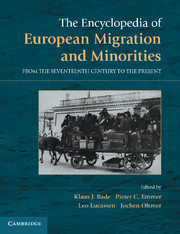Book contents
- Frontmatter
- Contents
- Preface to the English Edition
- Preface to the German Edition
- The Encyclopedia: Idea, Concept, Realization
- Terminologies and Concepts of Migration Research
- Countries
- Northern Europe
- Western Europe
- Central Europe
- Germany
- Austria
- Switzerland
- Southern Europe
- East-Central Europe
- Southeastern Europe
- Eastern Europe
- APPENDIX
- Index of Migration Types
- Index of Countries, Regions, and Places
- References
Germany
from Central Europe
Published online by Cambridge University Press: 05 June 2012
- Frontmatter
- Contents
- Preface to the English Edition
- Preface to the German Edition
- The Encyclopedia: Idea, Concept, Realization
- Terminologies and Concepts of Migration Research
- Countries
- Northern Europe
- Western Europe
- Central Europe
- Germany
- Austria
- Switzerland
- Southern Europe
- East-Central Europe
- Southeastern Europe
- Eastern Europe
- APPENDIX
- Index of Migration Types
- Index of Countries, Regions, and Places
- References
Summary
Migration in the German-speaking realm since the early modern period has encompassed not only peaceful cross-border movements and intercultural encounters. It has also included aggressive border crossings, flight across borders, and the exclusion of minorities within Germany and – after the violent expansion of Germany’s borders in the Second World War – in other parts of Europe. Throughout German history, however, not only have people moved across borders, but borders have also moved over people – minorities became majorities, majorities were turned into minorities, and natives into strangers in their own land.
A survey of the main currents in the migratory activity to and from Germany from the early modern period to the early 21st century, leaving aside the multitude of everyday and ubiquitous small-scale migrations that are impossible to keep track of, reveals a number of striking focal points: they include above all the early modern immigration of religious refugees or those expelled for religious reasons, the tradition-rich settlement migrations to eastern, east-central, and southeastern Europe until the early 19th century, and the transatlantic mass exodus until the late 19th century. This was followed by a reversal – increasing over the long term – in the direction of the migratory movements, down to the varied immigration movements to Germany in the late 20th and early 21st centuries. Throughout its history, however, the German-speaking realm was rarely simply a land of either emigration or immigration; instead, it was usually both at the same time, though with enormous differences in the epochal importance of the two great directions of migration and the problems and perspectives on integration they entailed.
- Type
- Chapter
- Information
- The Encyclopedia of European Migration and MinoritiesFrom the Seventeenth Century to the Present, pp. 65 - 82Publisher: Cambridge University PressPrint publication year: 2011

